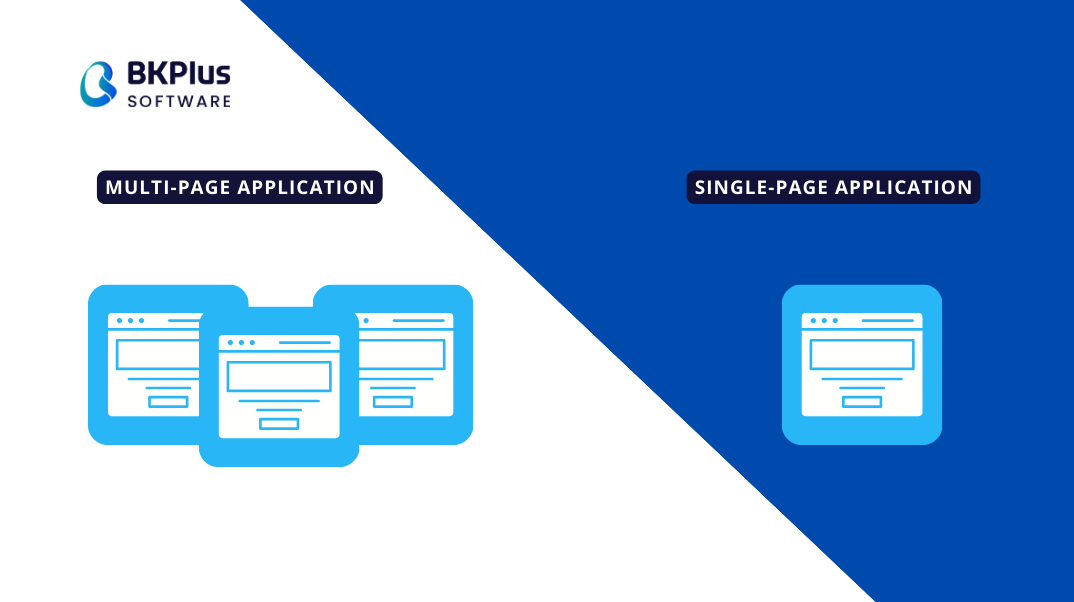Struggling to decide between a Single-Page Application (SPA) and a Multi-Page Application (MPA) for your business? In this blog post, you’ll find a comprehensive comparison between SPAs and MPAs to help you make the best choice for your web application development project.
Knowing the strengths and weaknesses of each approach will help you choose the architecture that best fits your business goals and target audience. Avoid costly missteps – discover the ideal balance between SPA and MPA for your needs!
What Is A Single-Page Application (SPA)?
The term Single-Page Application refers to a type of application that runs entirely in the web browser and does not require the entire page to be reloaded. The goal is faster transitions so that the website feels more like a native mobile app.
This approach provides a more responsive and seamless user experience as the page does not need to be completely reloaded with every interaction. SPAs are often used to create interactive and fast web applications using technologies such as Angular, React.js and Vue.js.
If you are looking to create a web application that is fast, responsive and easy to develop and maintain, then a single-page application is a good option.
Common examples of single-page applications are Gmail, Google Maps, Paypal and Airbnb.

What Is A Multi-Page Application (MPA)
Multi-Page Application (MPA) is a web application that loads a new page for each user action. A MPA consists of several static pages that load a new page for the server and then update the content of this page as required.
MPA is often used when an application needs to have different pages with different purposes. For example, an MPA has a homepage, a product catalog, a contact form and a user profile. Each page would have its own layout and functionality, depending on its purpose.
Common examples of multi-page applications are eBay, Amazon, Facebook and Twitter.
Now let’s find out the main difference between SPAs and MPAs by comparing their functionalities and capabilities in the table below.
What Are the Pros and Cons of SPA?
SPAs offer a lot to developers and users alike. They can make websites feel lightning-fast and intuitive. Additionally, they streamline the development process. However, SPAs also come with limitations. They can struggle with search engine optimization (SEO) and might introduce new security concerns. Let’s delve deeper into the pros and cons of SPAs.
Pros of SPA
Fast Loading Times and Performance
Unlike traditional websites, SPAs load everything you need at the outset, similar to Google Maps. This means you can navigate within the app without waiting for full page reloads. Instead, the app fetches new data as needed and updates what you see on screen. This streamlined approach makes SPAs feel faster than regular websites because there’s less communication between the app and the server.
Data Caching
Think of data caching as a shortcut for your device. It stores bits of information from websites and apps you use often, so you can access them faster the next time. This is especially helpful for SPAs where the initial load can be heavy. By caching data, SPAs can not only improve their loading speed but also enable some offline functionality. In short, data caching is a behind-the-scenes hero in web development, making things run smoother and faster.
Faster and Easier Software Development Life Cycle (SDLC)
Building a SPA can sometimes be a more cost-effective approach compared to a MPA. As SPAs allow you to reuse the same API for both your web app and potential mobile app.
Here at BKPlus Software, we’ve observed a trend of clients leveraging SPAs to create Minimum Viable Products (MVPs). This is a smart way to test the viability of your app concept before investing in a full-fledged product
Cons of SPA
Poor SEO Support
SPAs can struggle with SEO compared to MPAs. Search crawlers, the bots that search engines use to gather information, are better at processing websites built with separate HTML pages. This makes it more challenging for SPAs to rank well in search results.
Requires JavaScript to Function
Without JavaScript support, an SPA cannot take advantage of dynamic reloading. For this reason, your software development team must be proficient in JavaScript so that they can deliver a fully functional SPA. Also, if a user disables JavaScript in their web browser, then they won’t be able to use your SPA properly.

Security Concerns
The SPA architecture is prone to unique security risks. One of the biggest security concerns is cross-site scripting (XSS), where a threat actor injects malicious JavaScript code into the SPA and then uses that code to access the SPA on the client side.
What Are the Pros and Cons of MPA?
Despite their age, MPAs have a lot of advantages. They offer excellent SEO, scalability, and data analytics support. However, they do exhibit performance issues due to having multiple pages.
Pros of MPA
Excellent Scalability
MPAs are designed to handle a vast number of pages and offer flexibility in page length. This makes them ideal for websites like online stores and news outlets. These sites can easily create dedicated pages for each product, service, topic, or story, with the freedom to adjust the length of each page as needed.
Improved SEO Performance
MPAs are generally more search engine friendly than SPAs. Search crawlers can easily access and understand the content structure of an MPA. This allows search engines to effectively identify the target audience, relevant keywords, and popular pages on your website. Consequently, MPAs tend to have better search visibility compared to SPAs.
Data Analytics Support
Data analytics is a game-changer for web app owners. These tools unlock a treasure trove of user insights, including what people are interested in (favorite products, wishlists, purchase history), and how they interact with the app (page views, unique visitors, bounce rate). With this knowledge, web app owners can refine the browsing experience to keep users engaged.
For MPAs, data analytics is even more powerful. It allows owners to pinpoint which pages are underperforming and then optimize them for better results.
Cons of MPA
Slower Performance
In MPAs, navigating between sections often involves a full page reload or redirection to a new HTML page. This can feel slower than SPAs, which update content dynamically without reloading the entire page. This is because MPAs require the server to send complete new HTML pages for each user interaction.
More Time and Money to Develop
While MPAs offer a wider range of features and content spread across multiple pages, this complexity translates to higher development and maintenance costs. The increased number of pages can also lead to longer development times and more extensive software testing compared to a similar SPA.
Less Supportive of Reusable Code
Unlike a SPA, where you can use the same API (as well as third-party APIs) for both the web and mobile versions of the app, this is, sadly, not the case for MPAs. Therefore, if you wish to launch a web and mobile MPA, then the development team will devote extra time and resources to building the backend for both versions from scratch.
SPA Vs MPA – Key Technical Differences Between MPA And SPA
Here are the 12 core differences between MPA and SPA that help you to choose the right web development architecture that satisfies your business needs and requirements.
| No | Features & Functionalities | MPA | SPA |
| 1 | Page Loading | Need entire page load when navigating between the pages | Faster navigation as the page loads only once for the subsequent interactions |
| 2 | Performance | MPAs are quite slower than SPAs as they have a load the entire page for every new functionality and action | As the page loads only once, they are faster and more seamless for the user navigation |
| 3 | Initial Load Time | Less initial load time as each page needs its own resources to be fetched from the server. | Usually takes a longer time as all the necessary upfront resources are loaded for the subsequent actions. |
| 4 | SEO Friendliness | Considered as more SEO friendly as each page has its own URL and content which gives a boost to SEO | You might need an additional effort to ensure indexing by search engines for client-side rendering and dynamic content loading |
| 5 | Security | The server side rendering offers better protection for the attacks like cross-site scripting (XSS) | Need to take proper security measures to prevent client side rendering attacks like XSS and CSRF |
| 6 | Code Reusability | Limited code reusability as each page may require its own set of HTML, CSS, and JavaScript resources. | Better code reusability through component-based architecture, where reusable UI components can be shared across different views within the application. |
| 7 | Testing | Testing is simple and straight as each page is tested individually | Needs extra considerations, especially for client-side interactions which involve complex testing setups |
| 8 | Third-Party Integrations | Integrating third-party services or widgets can be simpler since each page operates independently. | Requires careful consideration of third-party integrations to ensure compatibility with client-side rendering and routing |
| 9 | Resource Utilization | Needs more server resources for the frequent page requests | Decrease the server load time as most of the app logic is handled on the client side |
| 10 | Scalability | Easy to scale for high traffic website as the load is distributed among various servers | Need to be careful especially for the huge amount of data |
| 11 | Browser History Management | Handled naturally by the browser, as each page load corresponds to a new entry in the history stack. | Requires explicit management of browser history using JavaScript, typically through HTML5 History API or routing libraries |
| 12 | Development Process | The web app development process is quite straightforward as the app is built on server and deployed on browser | The process comes quite cyclical, as the app is developed and deployed on the browser |
Conclusion
In summary, understanding the differences between single-page and multi-page applications is crucial. It will help you choose the right architecture for your web development project.
While SPAs offer better user experience and quicker loading times, MPAs excel in SEO and scalability. Consider your project’s specific needs, and weigh the advantages and disadvantages before deciding.
Developing MPA vs SPA with BKPlus Software Software
When opting for web development solutions, choosing the right architecture plays a significant role. If you’re still stuck on choosing your web architecture then our team is here to help you.
Being an experienced web app development company, BKPlus Software has a team of experts who can guide and build the best web app for your business/startup.
Get in touch with us! Let’s build your web app together!



